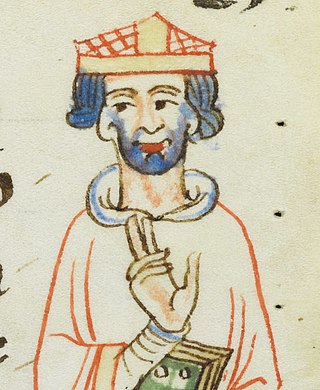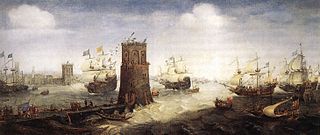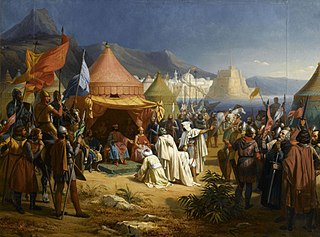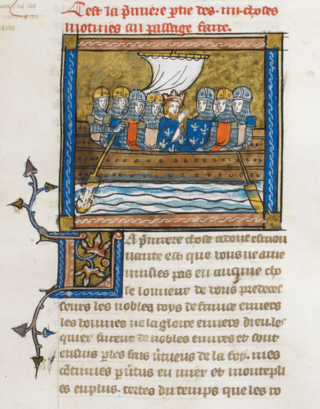Related Research Articles

Pope Honorius III, born Cencio Savelli, was head of the Catholic Church and ruler of the Papal States from 18 July 1216 to his death. A canon at the Basilica di Santa Maria Maggiore, he came to hold a number of important administrative positions, including that of Camerlengo. In 1197, he became tutor to the young Frederick II. As pope, he worked to promote the Fifth Crusade, which had been planned under his predecessor, Innocent III. Honorius repeatedly exhorted King Andrew II of Hungary and Emperor Frederick II to fulfill their vows to participate. He also gave approval to the recently formed Dominican and Franciscan religious orders.

The Sixth Crusade (1228–1229), also known as the Crusade of Frederick II, was a military expedition to recapture Jerusalem and the rest of the Holy Land. It began seven years after the failure of the Fifth Crusade and involved very little actual fighting. The diplomatic maneuvering of the Holy Roman Emperor and King of Sicily, Frederick II, resulted in the Kingdom of Jerusalem regaining some control over Jerusalem for much of the ensuing fifteen years as well as over other areas of the Holy Land.

The First Crusade (1096–1099) was the first of a series of religious wars, or Crusades, initiated, supported and at times directed by the Latin Church in the medieval period. The objective was the recovery of the Holy Land from Islamic rule. While Jerusalem had been under Muslim rule for hundreds of years, by the 11th century the Seljuk takeover of the region threatened local Christian populations, pilgrimages from the West, and the Byzantine Empire itself. The earliest initiative for the First Crusade began in 1095 when Byzantine emperor Alexios I Komnenos requested military support from the Council of Piacenza in the empire's conflict with the Seljuk-led Turks. This was followed later in the year by the Council of Clermont, during which Pope Urban II supported the Byzantine request for military assistance and also urged faithful Christians to undertake an armed pilgrimage to Jerusalem.

The Eighth Crusade was the second Crusade launched by Louis IX of France, this one against the Hafsid dynasty in Tunisia in 1270. It is also known as the Crusade of Louis IX Against Tunis or the Second Crusade of Louis. The Crusade did not see any significant fighting as King Louis died of dysentery shortly after arriving on the shores of Tunisia. The Treaty of Tunis was negotiated between the Crusaders and the Hafsids. No changes in territory occurred, though there were commercial and some political rights granted to the Christians. The Crusaders withdrew back to Europe soon after.

The Council of Clermont was a mixed synod of ecclesiastics and laymen of the Catholic Church, called by Pope Urban II and held from 17 to 27 November 1095 at Clermont, Auvergne, at the time part of the Duchy of Aquitaine.

The Fifth Crusade (1217–1221) was a campaign in a series of Crusades by Western Europeans to reacquire Jerusalem and the rest of the Holy Land by first conquering Egypt, ruled by the powerful Ayyubid sultanate, led by al-Adil, brother of Saladin.

Lord Edward's crusade, sometimes called the Ninth Crusade, was a military expedition to the Holy Land under the command of Edward, Duke of Gascony in 1271–1272. It was an extension of the Eighth Crusade and was the last of the Crusades to reach the Holy Land before the fall of Acre in 1291 brought an end to the permanent crusader presence there.

Charles Mills (1788–1826) was an English historian. His works include History of the Crusades for the Recovery and Possession of the Holy Land, History of Mohammedanism and History of Chivalry.

The siege of Tripoli lasted from 1102 until July 12, 1109. It took place on the site of the present day Lebanese city of Tripoli, in the aftermath of the First Crusade. It led to the establishment of the fourth crusader state, the County of Tripoli.
The Crusades were a series of religious wars initiated, supported, and sometimes directed by the Latin Church in the medieval period. The best known of these Crusades are those to the Holy Land in the period between 1095 and 1291 that were intended to recover Jerusalem and its surrounding area from Islamic rule. Beginning with the First Crusade, which resulted in the recovery of Jerusalem in 1099, dozens of Crusades were fought, providing a focal point of European history for centuries.
Linn City was a community in Clackamas County, Oregon, United States, that existed from 1843-1861 and was destroyed in the Great Flood of 1862. The former site of Linn City was incorporated into the city of West Linn.

Mongol raids into Palestine took place towards the end of the Crusades, following the temporarily successful Mongol invasions of Syria, primarily in 1260 and 1300. Following each of these invasions, there existed a period of a few months during which the Mongols were able to launch raids southward into Palestine, reaching as far as Gaza.

The Eastern Roman (Byzantine) imperial church headed by Constantinople continued to assert its universal authority. By the 13th century this assertion was becoming increasingly irrelevant as the Eastern Roman Empire shrank and the Ottoman Turks took over most of what was left of the Byzantine Empire. The other Eastern European churches in communion with Constantinople were not part of its empire and were increasingly acting independently, achieving autocephalous status and only nominally acknowledging Constantinople's standing in the Church hierarchy. In Western Europe the Holy Roman Empire fragmented making it less of an empire as well.
The medieval lost town of Newtown Jerpoint is just west of the Cistercian Jerpoint Abbey, near Thomastown, County Kilkenny, Ireland. It is located 3.2 km south west from Thomastown just off the R448 regional road. In the grounds of the privately owned Jerpoint Park. St. Nicholas’s Church and graveyard are in the town, where the earthly remains of St. Nicholas of Myra are said to be buried. Belmore House stands at the top of the town.
History of the Crusades may refer to:
Christopher Tyerman is an academic historian focusing on the Crusades. In 2015, he was appointed Professor of History of the Crusades at the University of Oxford.
Historians of the Crusades: the auxiliary sciences of history considers those sources on the Crusades that are concerned with auxiliary sciences of history that include archaeology and numismatics. These sources are used by historians to supplement documentary information about the subject events, providing verification and in some cases otherwise unknown clues as to the past. The most prominent of these is the general study of archaeology, which typically includes the following items:

The Fall of Outremer describes the history of the Kingdom of Jerusalem from the end of the last European Crusade to the Holy Land in 1272 until the final loss in 1302. The kingdom was the center of Outremer—the four Crusader states—formed after the First Crusade in 1099 and reached its peak in 1187. The loss of Jerusalem in that year began the century-long decline. The years 1272–1302 are fraught with many conflicts throughout the Levant as well as the Mediterranean and Western European regions, and many Crusades were proposed to free the Holy Land from Mamluk control. The major players fighting the Muslims included the kings of England and France, the kingdoms of Cyprus and Sicily, the three Military Orders and Mongol Ilkhanate. Traditionally, the end of Western European presence in the Holy Land is identified as their defeat at the Siege of Acre in 1291, but the Christian forces managed to hold on to the small island fortress of Ruad until 1302.

The theme of recovery of the Holy Land was a genre in High–Late Medieval Christian literature about the Crusades. It consisted of treatises and memoranda on how to recover the Holy Land for Christendom, first appearing in preparation for the Second Council of Lyon in 1274. They proliferated following the loss of Acre in 1291, shortly after which the permanent Crusader presence in the Holy Land came to an end, but mostly disappeared with the cancellation of Philip VI of France's planned crusade in 1336 and the start of the Hundred Years' War between England and France the next year. The high point of recovery proposals was the pontificate of Clement V.
References
- ↑ Mills, C. (1822). The history of the crusades for the recovery and possession of the Holy Land. 3d ed. London.